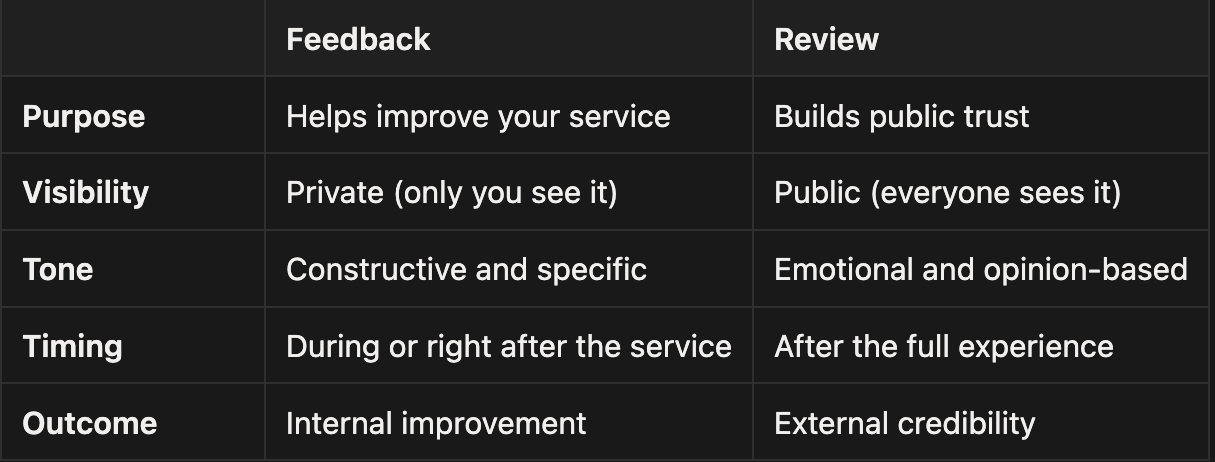Feedback vs Review: What’s the Difference?

Key Takeaways
- Feedback improves your service internally.
- Reviews build public trust and visibility.
- Use both to grow and strengthen your reputation.
Intro
You’ve finished a great job, the customer smiles, says “thank you,” and walks away happy. You expect a glowing review — but it never comes.
Then the next day, someone else quietly messages you about a small issue, and you’re not sure if that counts as feedback, criticism, or something in between.
It’s a common situation for many business owners.
Knowing the difference between feedback and reviews is what helps turn everyday interactions into lasting trust and visible growth.
Feedback and Review Overview
Feedback and reviews share similarities but serve different goals. Here’s a quick look at what they are and how each impacts your business.
What Is Feedback?
Feedback is private input from a customer meant to help you improve.
It’s usually shared directly with your team through messages, forms, or conversations, and helps identify what’s working and what needs improvement.
Example
A client messages your spa saying, “The facial was great, but the music was a little loud.”
That’s feedback. It’s personal, constructive, and meant to make your service better next time.
ALSO CHECK: What are the Different Types of Feedback?
What Is a Review?
A review is public feedback shared on Google, Facebook, or Yelp.
It tells the world how your customer felt about your product or service, and it directly affects how new customers perceive your business.
Example
That same client posts on Google, “★★★★★ Best facial I’ve ever had! Highly recommend!”
That’s a review. It helps strengthen your reputation and attract more customers.
RECOMMENDED: What is a Negative Review?
What Is the Difference Between a Review and Feedback?
Although both share opinions, they serve different purposes.
Here’s a clear breakdown:

Purpose: Growth vs Trust
Feedback is focused on improvement.
It gives you actionable insights on what’s working and what needs adjustment so your business can evolve.
For example, a customer might mention that the waiting time could be shorter or that the staff was friendly but seemed rushed. These insights help you fine-tune your process and overall customer experience.
Reviews, on the other hand, are about credibility.
They tell potential customers whether your business delivers what it promises. A string of positive reviews can instantly build trust and encourage new people to try your service.
ALSO CHECK: What’s the Difference Between a Bad Review and Defamation?
Visibility: Private vs Public
Feedback is typically private.
It’s shared directly with your business through surveys, messages, or conversations, allowing you to handle concerns discreetly and professionally.
This privacy creates space for honest responses and helps prevent negative experiences from spreading online before you can address them.
Reviews are public.
They appear on platforms like Google, Yelp, or Facebook, where anyone can see them. Public reviews amplify your reputation, helping you attract more customers, but they also highlight areas where your business may need improvement.
Tone: Constructive vs Emotional
Feedback tends to be constructive and objective.
Customers often point out both the good and the bad with the goal of helping you improve. It’s specific, thoughtful, and focuses on outcomes.
Reviews are more emotional and opinion-driven.
They’re written from a personal perspective, often filled with enthusiasm or frustration, which makes them powerful in influencing other people’s decisions.
RECOMMENDED: Reviews vs Testimonials
Timing: During vs After
Feedback usually happens during or immediately after a service.
It captures the customer’s experience while it’s still fresh, allowing you to respond quickly and make adjustments in real time.
Reviews typically come after the full experience.
Once a customer has reflected on the entire interaction, they share their overall satisfaction publicly. Reviews represent the final impression of your business rather than the moment-to-moment experience.
Outcome: Improvement vs Credibility
Feedback fuels internal growth. It’s a tool for continuous improvement—helping you build better systems, train staff effectively, and refine customer service.
Reviews drive external credibility. They shape your online reputation, improve search visibility, and influence purchasing decisions. A strong review profile can directly increase referrals and conversions.
In short:
Feedback helps you get better.
Reviews help you get discovered.
When you manage both effectively, your business doesn’t just improve—it grows.
When to Ask for a Review vs Feedback
Knowing when to ask for each can make a huge difference in your results.
Ask for a Review When…
- The customer expresses clear satisfaction with your service.
- You’ve completed a successful project or appointment.
- You want to build your Google or social media reputation.
- You’re launching, rebranding, or improving local visibility.
- You want to strengthen your SEO and attract new leads.
Ask for Feedback When…
- You’re testing a new product, service, or workflow.
- A client seems hesitant or has suggestions.
- You want to catch small issues before they become bad reviews.
- You’re training staff or improving customer experience.
- You’re collecting insights for internal improvement.
How SurgePoint Helps You Manage Reviews and Feedback
SurgePoint is a reputation management platform that bridges the gap between private feedback and public reviews. It helps businesses collect insights, turn positive feedback into visible reviews, and protect their reputation through automation.
Key Features
- Automated Review Requests – Gather more reviews by automatically inviting happy customers to share their experience.
- Feedback Filtering – Capture private feedback first to resolve issues before they appear publicly.
- Referral Campaigns – Turn satisfied feedback into referrals that drive new business.
- Smart Responses – Respond to reviews quickly with professional, brand-aligned templates.
- Insights Dashboard – Track customer sentiment and review trends to improve both service quality and visibility.
Industries We Serve
From law firms and med spas to dental, medical, plumbing, and landscaping services, SurgePoint helps businesses strengthen both sides of reputation—improving through feedback and growing through reviews.
Conclusion
Understanding the difference between feedback and reviews is the first step to building a stronger reputation.
If you’re planning to put these ideas into action, we wish you the best of luck. And if you’d like to learn more about how we approach this at SurgePoint, you can explore our insights on reputation marketing and review marketing, or check out our full blog for more guides and strategies.
Curious about how fake or misleading reviews can affect your reputation? We’ve also shared our take on fake Airbnb reviews and what businesses can learn from them.
If you have questions or want to talk about how to strengthen your own review and feedback process, feel free to reach out to us anytime at info@thesurgepoint.com.




